Ram
On Growing Emirates
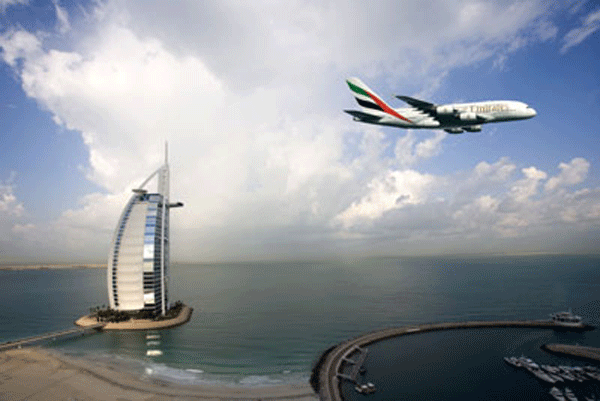
The A380 flew high, wide and handsome above Dubai’s landmark
Burj Al Arab Hotel, while sweeping above thousands of star-struck
observers on the ground along the coast six times in different formations,
with the nine French Air Force jets flying color guard. |
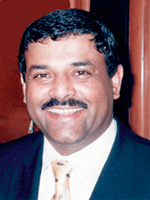 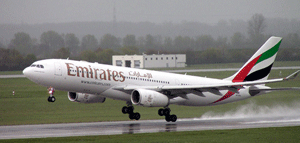 Ram
Menen, Emirates SkyCargo Senior Vice President Cargo takes a deep breath. Ram
Menen, Emirates SkyCargo Senior Vice President Cargo takes a deep breath.
SkyCargo has just signed a mega-deal to
purchase eight Boeing B777-200LRF freighters, the largest single day order
that the U.S. manufacturer has ever received for the type, as part of
a 42-airplane order of B777’s, that absolutely sent writers looking
for new superlatives at the recently concluded Dubai Air Show.
To put the order in some kind of perspective,
the deal meant so much to Boeing that the top executive of the U.S. airplane
manufacturer took his show on the road visiting Dubai for the first time
in his life to make sure the deal was done, and to stand with other executives
as the announcement was beamed out across the world.
Combination of these advanced twin-engine,
all cargo airplanes that can lift 103 tons apiece and fly 5,000 nautical
miles all the way from Dubai to Tokyo non-stop, will put Emirates both
near the top (or over it) in the race as one of the largest and most profitable
airline/cargo operations in the world.
But with deliveries set to commence in 2009
and continue unabated for years after that, Emirates’ bold B777
fleet will create a new backbone for the Dubai based carrier’s world
service expansion plan.
“It’s an absolutely brilliant
airplane,” Ram says his eyes widening.
“By the time all is said and done,
based on current orders, our all-cargo fleet will be approaching 20 aircraft
within the next eight years.
“With the right mix of heavy lifters
such as B777 and A380 and B747, we also have added A310-300Fs to our medium-haul
regional mix with great success.
“Right now we are taking markets cautiously
as worldwide slowdown continues.
“But we know that the cargo business
will continue its upward spiral and keep growing, even as pauses along
the way afford us the opportunity to sharpen our approach.
“Our current success is due in no
small part to being in the right markets at the right time, while carefully
managing assets and keeping a close eye on costs especially runaway fuel
that is affecting everyone.
“We have assembled a first-class professional
air cargo sales and service team worldwide.
“SkyCargo is close to the markets
we serve with an open expansive attitude toward building relationships
in all aspects of our business that are both dependable and long lasting.
“We know that being a leader in air
cargo for the long haul is no easy task.
“To secure long lasting relationships
takes imagination, determination and the willingness to both invest in
our product and get paid a fair price for what we do.
“SkyCargo earns each account, one
customer at a time.”
Ram Menen is the most public face on a SkyCargo
organization that has roared out of the desert during the past two decades
from a place that used to be thought of as little more than “Oasis
Dubai”.
Today, Dubai is hosting one of the biggest
building booms on earth that in turn is also fueling almost everything
else in the region including Emirates Airline.
But the amount of pride toward Emirates
that is felt all across this region from people in all walks in life was
keenly evident last weekend when an Airbus A380 aircraft in full Emirates
livery affected a fly-by above Dubai’s Jumeirah Beach, accompanied
by the Patrouille de France, the French Acrobatic Air Force Team.
As spontaneous applause erupted from below,
the mighty sky vessel, and the world’s largest commercial aircraft,
glided gracefully past a place drawn together at this historic moment,
flanked by the French acrobatic jets which streamed red, white and blue-colored
trails in the sky.
Emirates is the world’s largest customer
for the A380 aircraft with the first of its 45 A380’s on order to
be delivered in early 2007.
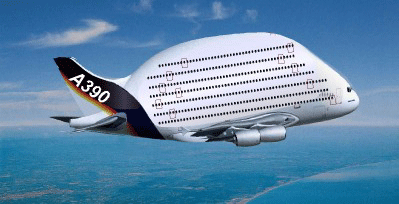 As the year winds down with mega-news of the biggest commercial
airliners and cargo numbers as leading indicator of where the world
economy goes next, the dreamers and doers are also looking ahead.
As the year winds down with mega-news of the biggest commercial
airliners and cargo numbers as leading indicator of where the world
economy goes next, the dreamers and doers are also looking ahead.
Here is an all-cargo version of a seven story transport
from Airbus that could carry The Statue of Liberty on loan from
Ellis Island to Dubai non-stop where the Icon would be centerpiece
at a future air show.
Couldn’t happen you say?
Never say never, is a better answer!
|
“Some people may look at our aircraft
acquisition program and wonder:
“Where will the cargo and passenger
business come from?
“We know based just on the big construction
project at Jebel Ali International Airport (JXB) alone, that we will need
considerable lift to satisfy demand being created here in Dubai that will
be served by the new airport city gateway.
“You cannot take an isolated view
of Emirates growth plan without considering the home market we serve,
that seems to be growing up and out all over the place, all at once.
“The development plans in both business
and real estate here are just tremendous and bound to continue throughout
the next decades of the 21st Century.”
Earlier this month on November 16, SkyCargo
deepened its service network with a second daily flight into New York
City, JFK.
“The new service adds capacity to
New York where business has been good.
“We also serve New York with twice-weekly
Boeing 747 freighter services with a total capacity of 225 tons.
“Belly-hold capacity across that route
segment in the Airbus A340-500 aircraft is about 15 tons.
“But New York is an extremely important
destination for Emirates as both the great commercial center of the world
with a strengthening U.S. dollar that is building exports.
"The early morning departure of our
new daily service to New York is ideal for priority and time-sensitive
products.
“As example the night flight from
Dubai allows the cargo division to carry mail, parcels and courier packages
from integrators and post offices at the end of the working day gathered
from around our route network in the Middle East, Indian subcontinent,
Far East, Australasia and Africa.
“The flight arrives in New York in
the morning, with shipments ready for onward delivery to companies.”
In addition to EK’s second New York
City frequency, daily flights to and from Dubai to Korea that commenced
May 1 have done well offering about 13 tons belly lift space for cargo
via the A340-600.
Another ’05 start up to Alexandria,
Egypt marked the second gateway to that country after Cairo.
Early next year Emirates new nonstop daily
service between Dubai and Beijing will begin February 1, 2006 with an
Airbus 340-300.
Beijing will be Emirates' fourth destination
in China, after Shanghai, Hong Kong and Dalian (cargo-only). Emirates’
daily services to Hamburg, its fourth German gateway, will also launch
on February 1, 2006.
“We are excited about both Beijing
and Hamburg.
Beijing will offer our service the capital
of China and all the growth potential and excitement there. Hamburg is
the second largest city in Germany.
As a long-time center for maritime commerce,
the air cargo specialist can only salivate at the possibilities of adding
SkyCargo service to the Middle East and our network beyond.”

UAE
At Thirty Four
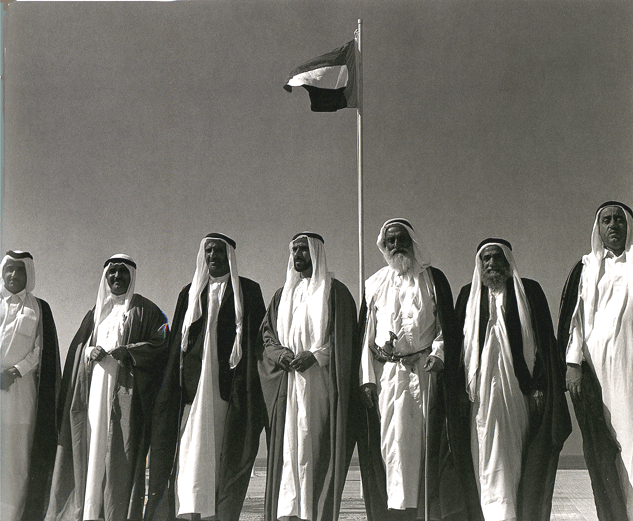
From
left to right Sheikh Maktoum bin Rashid Al Maktoum, Crown
Prince of Dubai; Sheikh Khalid bin Mahammed Al Qassimi,
Ruler of Sharjah; Sheikh Rashid bin Saeed Al Maktoum, Ruler
of Dubai; Sheikh Zayed bin Sultan Al Nahyan, Ruler of Abu
Dhabi; Sheikh Rashid bin Humaid Al Nuaimi, Ruler of Ajman;
Sheikh Mohammed bin Hamad Al Sharqi, Ruler of Fujairah;
and Sheikh Rashin bin Ahmed Al Mualla, Crown Prince of Umm
Al Quwain. This picture was taken December 2, 1971 under
the first flag of The United Arab Emirates.
Once upon a time the United
Arab Emirates was a series of small sheikhdoms on the coastline
of the Persian Gulf that prospered in the Middle East from
the seventh century onwards.
After the arrival of European
colonists in the 1820’s and attacks on British-owned
shipping operating in the Gulf region, local Arab rulers
signed a treaty with the British in 1853, under which they
accepted British military protection.
The sheikhdoms which became
known as the Trucial States carried on, largely unmolested
and ignored until the 1950's when the British beat retreat
lifting controls as part of its post-imperial reality.
The United Arab Emirates came
into being as an independent state on December 2, 1971.
This Friday (December 2),
the United Arab Emirates marks the thirty-fourth anniversary
of its emergence onto the world stage.
The UAE, a federation of seven
emirates, Abu Dhabi, Dubai, Sharjah, Ra's al-Khaimah, Fujairah,
Umm al-Quwain and Ajman, lies in the southeastern corner
of the Arabian peninsula.
With an area of around 83,400
square kilometers, and with a population of a little over
5 million, due to reforms of government institutions designed
to improve transparency and efficiency, UAE has achieved
much in terms of its economic and social development, while
it has also continued to play an increasingly active role
in international affairs.
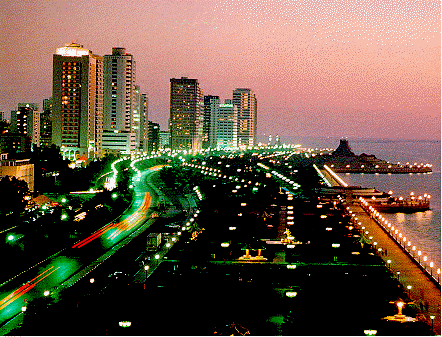 Economic
progress has been fuelled in part by the marked rise in
world oil and gas prices. Economic
progress has been fuelled in part by the marked rise in
world oil and gas prices.
Night view of Abu Dhabi, capitol city of the Emirates
With the fourth largest proven oil reserves in the world,
and the fourth largest proven gas reserves too, the UAE produces
around 2.5 million barrels of oil a day, most of which is
exported.
This year, they are expected
to reach US$ 40 billion, up from US$ 30 billion in 2004, with
a further rise to US$ 42.7 billion being predicted by the
U.S. Energy Information Agency for next year.
At the same time though, the
UAE has long pursued a policy of diversifying its economy
away from dependence on oil and gas, and the hydrocarbons
sector now accounts for less than a third of Gross Domestic
Product.
Other sectors of importance
are heavy industry (including petrochemicals and aluminum)
and the financial and services sectors.
The inauguration during the
year of the Dubai International Finance Centre, DIFC, is expected
to provide a major boost to the country's finance industry.
Trade is also important—the
country's major ports, such as those in Dubai, Sharjah and
Fujairah, are significant not just for imports and exports,
but also for trans-shipment, evidence of the way in which
the UAE has capitalized on its strategic location between
East and West to emerge as a major commercial hub.
That process has been enhanced
by growth at its six international airports, including those
of Dubai and Abu Dhabi, the latter now commencing a multi-billion
dollar expansion plan.
In November 2005, plans were
announced for another international airport, at Jebel Ali,
southwest of Dubai, which when completed, will be the largest
airport in the world.
Among the key beneficiaries
of this investment in the transport infrastructure will be
the country's three fast expanding airlines, Emirates, based
in Dubai, and the newer Etihad, based in Abu Dhabi, and Air
Arabia, based in Sharjah.
All three airlines, as well
as other carriers serving the UAE, have benefited from continuing
growth in the tourism sector, which is already contributing
around 20 percent of Dubai's economy, with over ten million
visitors a year arriving from around the globe.
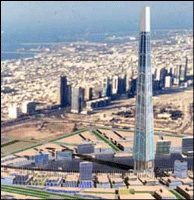
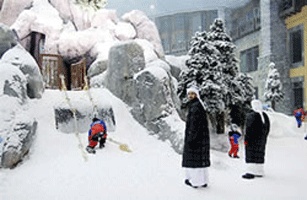 Whether
it is the tallest building in the world under construction,
or an indoor winter wonderland that opens Friday, Dubai is
growing up all at once as the United Arab Emirates celebrates
thirty four years. Whether
it is the tallest building in the world under construction,
or an indoor winter wonderland that opens Friday, Dubai is
growing up all at once as the United Arab Emirates celebrates
thirty four years.
Other emirates, too, are benefiting
from the emergence of the UAE as one of the world's most
popular holiday destinations, with hotels reporting record
levels of occupancy.
Key to this interest are exciting
and different attractions such as the world's premier winter
wonderland.
When the Ski Dubai Dome opens
this Friday inside a brand new, shopping center called Mall
of the Emirates, visitors, many of whom are Gulf Arabs,
could have a life altering experience as they touch snow
for the first time.
Ski Dubai, is a man-made mountainous scene as big as three
football fields with 6,000 tons of snow that holds up to
1,500 visitors.
Après-ski pleasures
include hot chocolate or a fondue by a crackling fireplace
at either the Avalanche or St. Moritz cafes, perched on
the slopes.
The tourism boom is also being
complemented by growth in the exhibitions and conferences
market, this, in turn, prompting the building of more hotels
and conference centers.
Perhaps the most visible sign
of growth, however, is the remarkable boom in property development,
which began several years ago in Dubai, but now, is spreading
to the other emirates.
Superlatives have become almost
commonplace, with Dubai currently constructing the tallest
building in the world (Burj Dubai, or Dubai Tower), the
largest reclamation projects and the world (the offshore
Palm Islands) as well as many other projects.
Around twenty percent of all
of the world's tower cranes are now said to be working in
Dubai.
|
|
|



